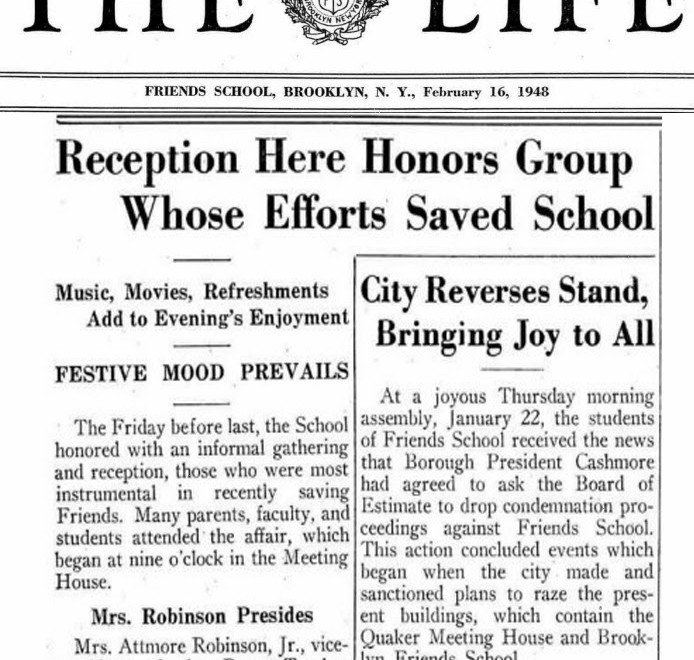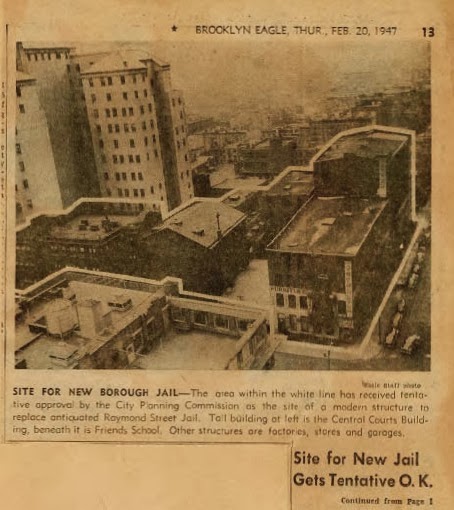1947-48, the year BFS was nearly lost, Part II

 |
| Celebrating our school having been saved, The Friends School Life, February 16, 1948 |
This week, I’m following up on last week’s post concerning the discovery of the 1947-1948 Fight to Save BFS Scrapbook which allowed us to finally remember an incredibly important moment in our school’s history. I’d like to share a few items since historical events are deeply nuanced and people’s actions even more so.
The idea of creating a civic center and replacing the Raymond Street Jail in Downtown Brooklyn had been kicked around for over a decade. A 1935 article from The Brooklyn Daily Eagle shows Brooklyn Borough President Raymond Vail Ingersoll suggested a civic center stretching from the Borough Hall building at Joralemon and Court Streets to the intersection of Fulton and Washington Streets, at what is now the northern end of Cadman Plaza Park. That article mentions that Ingersoll felt Schermerhorn and Smith Street was an ill-conceived location for the 1929 Central Court building. However, the Schermerhorn and Smith Street site had been the site of the County Court which offered the same services as Central Court. It made sense to rebuild the new courthouse on the site of the old courthouse. Unfortunately, the Raymond Street Jail remained almost a mile away from the courthouse, at the corner of what is now Myrtle Avenue and Ashland Place (Ashland Place used to be Raymond Street, and was renamed because of the jail’s notoriety). Eliminating the Raymond Street Jail and creating the Brooklyn House of Detention next to Central Court was a pillar of all post-1940 plans for Brooklyn’s Civic Center. It makes sense, but, of course, that’s where BFS and the Brooklyn Meeting House were located.
BFS and the Brooklyn Meeting House were eventually saved, yes, but an important aspect of the plan for the Brooklyn Civic Center that did see fruition and also affected the Schermerhorn properties owned by New York Monthly Meeting was the widening of Boerum Place, also known as Adams Street and, more recently as Brooklyn Bridge Boulevard. This 1959 street widening resulted in the demolition of the factory on the corner of Boerum Place and Schermerhorn and in the reduction of some of the school’s playground on the eastern side of the Brooklyn Meeting House. Compensation for the loss of this property was made by the City of New York to New York Monthly Meeting, which later decided that those funds would be used for the school’s benefit as it was the school’s playground which was reduced by the street widening.
Brooklyn Borough President John Cashmore succeeded Raymond Vail Ingersoll who had been Brooklyn Borough President from 1934 to his unexpected death in 1940. Ingersoll was also a direct descendant of a noted Quaker family on his mother’s side, the Vails of New Jersey. Upon his death, Ingersoll was allowed burial in Friends Cemetery in Prospect Park as his mother was a Quaker, even though he was not a member of any Friends meeting – I find it charming that Ingersoll seems to be the only NYC Parks Commissioner (Brooklyn, 1913 to 1917) buried within a New York City park. Additionally, Ingersoll enrolled his children for a brief time at Brooklyn Friends School. Some of Ingersoll’s grandchildren also attended BFS. There is no solid proof, but I feel strongly that Ingersoll might have protected the properties owned by New York Monthly Meeting: his thoughts for a Brooklyn Civic Center did not seem to extend to Schermerhorn Street and he had personal ties to BFS and to the Society of Friends. Ingersoll’s widow was even one of the “leading citizens” who signed the January, 1948 letter of protest sent to NYC Mayor William O’Dwyer in January, 1948 (see page 17 of our scrapbook).
Take a look at this December 7, 1941 article from The Brooklyn Daily Eagle in which the plan for the Brooklyn civic center is more fully revealed. While there were earlier articles and editorials in The Eagle on the civic center, this article states plainly that Friends School needed to be acquired for the new prison and the accompanying map plainly shows the prison would be on the site of our historical home on Schermerhorn Street. Hold on, what was that date again? December 7, 1941, “A date which will live in infamy” – the bombing of Pearl Harbor and World War II must have been first and foremost in everyone’s minds on that day and would remain so for years. It would be easy to forget about the plan to replace BFS and the Brooklyn Meeting House with a new city prison. The proposal for the Civic Center changed little over the years leading to 1947, with plans put forth by Borough President John Cashmore, City Comptroller Joseph McGoldrick and New York Supreme Court Justice Charles Lockwood, but the plans were very similar and always included placing the new prison on the site of Brooklyn Friends School and Brooklyn Monthly Meeting.
One of the hardest moments in my early research for our 2007-2008 article was my realization that the City’s plans for the site of BFS and Brooklyn Monthly Meeting had been public since 1941 and no protest seemed to have been made by anyone for six years, especially by the owners of the site, New York Monthly Meeting – one would imagine the Meeting would have been contacted by the City of New York at some point prior to 1947. However, a news clipping on page 13 of our scrapbook indicates New York Monthly Meeting was first notified of the city’s intent to condemn its property in January, 1947 and this January notification is confirmed as a personal phone call on page 49 of our scrapbook in the December letter of protest to Borough President Cashmore from the leadership of BFS and New York Monthly Meeting.
 |
| Map of City Planning Commission’s Proposed Downtown Brooklyn Civic Center as published in The New York Times, October 13, 1944 |
When Mary Doty gave me her family papers detailing New York Monthly Meeting’s plans in case its property was lost to NYC, she provided me with New York Monthly Meeting’s action steps from at least June to October of 1947. The documents detailed the depreciation of the existing buildings, the potential monies that might be received from a condemnation award, and the costs of a potential move for Brooklyn Friends School and the Brooklyn Meeting House, to a site several blocks away, further down Schermerhorn Street. Also included were two sets of requirements for a new school building – one proposed by Principal Warren Cochran and one by former Principal S. Archibald Smith. No matter, it was apparent then that costs for rebuilding BFS and for the in-tact transportation of the Brooklyn Meeting House to a new site were simply prohibitive (see pages 149 to 171 of our scrapbook).
One BFS alum shared an important insight into that fight. He recalled that New York Monthly Meeting was not going to protest against the City condemnation, but planned to accept the City’s offer to acquire the Schermerhorn property. This alum recalled that when the loss of Brooklyn Friends School and the Brooklyn Meeting House were publicly questioned and it seemed that New York Monthly Meeting was going to accept the City’s offer, it was the leaders of other religious organizations in New York City who applied pressure to New York Monthly Meeting. Those leaders felt strongly that if the City of New York was allowed to seize the property of one religious organization, that the City would have carte blanche to do the same to every religious organization in NYC. News clippings in the scrapbook indicate that many religious organizations circulated petitions to save the school in the first wave of protests.
Another BFS alum shared an even more important insight into that time. Sally Szold Boasberg ’54 is the daughter of Parent Teacher Club President Helen Szold who was so deeply involved in the fight to save Brooklyn Friends School from the very beginning. Sally wrote me a few years ago: “Reading your piece about saving BFS also brought back so many memories. What you didn’t include in the article was the role of Robert Moses, who behaved very badly. At one point he promised the school that they could have a new location at Cadman Plaza, which of course wasn’t built for another 30 years. I think it was about the only time that Moses was beaten on something he really wanted to do, so of course we all celebrated. My mother had been frustrated because the [New York Monthly] Meeting didn’t think it right to oppose the demolition, and [it] was basically controlled by the Manhattan Friends people. Just getting their consent to launch a campaign was a huge struggle. I think she probably had more fun with the campaign than almost anything else she did while I was growing up… It was a very good lesson for me in the power of citizen activism, a lesson I have put to good use any number of times during my adult years.



